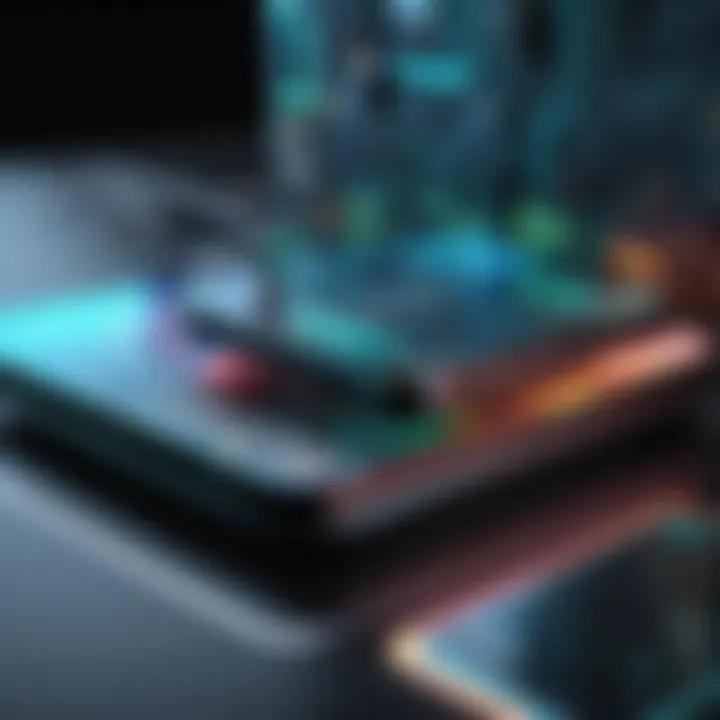Exploring Live Wallpapers and Lockscreens: A Technological Perspective


Intro
The evolution of technology shapes many aspects of daily life. One area showing significant innovations is digital customization. Live wallpapers and lock screens serve as a notable example, transforming how users engage with their devices. These features not only provide aesthetic appeal but also enhance user experience by incorporating interactive elements. This article dissects the technological evolution, the unique characteristics, and the overall implications of live wallpapers and lock screens on user privacy.
Key Features
Design and Build Quality
Live wallpapers feature dynamic visuals that breathe life into the user interface. The design ranges from simple animations to intricate, immersive experiences. Their build quality is equally critical. High-resolution graphics and smooth transitions play a vital role in user satisfaction. Conversely, poorly designed wallpapers can lead to distortion and lag, detracting from the user experience.
Customization is essential in this realm. Users often have the opportunity to adjust elements such as speed, color themes, and interaction methods. This flexibility allows personalization to match individual preferences, making the device feel uniquely theirs.
Display and Performance
The display performance of live wallpapers is closely tied to the device's capabilities. Some wallpapers may function well on high-end devices while struggling on budget models. It is vital to understand the impact of live wallpapers on device performance. They can consume more battery and RAM compared to static alternatives. Users often see a drop in performance metrics when several applications run in the background.
"Selecting the right live wallpaper can profoundly affect a device's performance and user satisfaction."
The trade-off between visual appeal and device functionality is an ongoing concern. Users must make informed choices to balance aesthetics with system efficiency.
Product Specifications
Technical Specifications
Understanding technical specifications is crucial for optimal use. Live wallpapers often require advanced graphical processing capabilities. For instance, devices featuring Qualcomm Snapdragon 888 or Apple's A14 Bionic chip typically handle these tasks more efficiently than older processors.
Other specifications to consider include:
- Resolution: Higher resolutions deliver better visuals but require more processing power and battery life.
- Frame Rate: A smoother experience is achieved at a minimum of 30 frames per second.
- Animation Style: Different styles can vary in resource usage.
Compatibility and Connectivity
Live wallpapers are compatible with various operating systems, notably Android and iOS. It is essential to confirm if a particular wallpaper aligns with a device’s OS version. Moreover, certain animations may require a stable internet connection for real-time updates or interactions, enhancing the overall experience.
Overall, ensuring compatibility with the device enhances the user’s engagement with their live wallpaper or lock screen.
Understanding Live Wallpapers
Live wallpapers stand out as a significant feature in modern mobile and desktop operating systems. Their importance lies in their ability to enhance user experience and offer unique customization options. Users increasingly look for ways to express their individuality, and live wallpapers facilitate this desire through vivid visuals and interactivity.
Definition and Functionality
Live wallpapers are animated or interactive background images that users can set on their devices instead of traditional static images. These wallpapers react to user interactions or change over time, creating a dynamic visual experience. They can provide functionality beyond mere aesthetics; for example, certain live wallpapers can show information like weather updates or notifications.
Technological Development
Early Concepts
In the beginning stages, live wallpapers emerged from the need for dynamic interfaces that could engage users. Early concepts were simple animated backgrounds that often featured basic movements or color changes. The introductory innovation of these wallpapers was their capacity to bring a sense of life and movement to otherwise static screens. However, they were typically resource-intensive, which limited their appeal across devices.
Major Innovations
As technology advanced, major innovations started to appear. The development of more efficient algorithms allowed live wallpapers to consume fewer resources while maintaining visual intensity. For instance, the inclusion of motion sensors in devices enabled wallpapers to respond to the tilt of the device, making the experience more engaging. These enhancements made live wallpapers a popular option for users looking to personalize their devices without sacrificing performance.
Current Trends
Today, current trends in live wallpapers include integration with augmented reality and artificial intelligence. Users are increasingly attracted to live wallpapers that adapt to their surroundings or learn from their usage patterns. This responsiveness ensures that users have a fresh and tailored experience. The growing emphasis on user customization has positioned live wallpapers as a central feature in modern operating systems.
Types of Live Wallpapers
Live wallpapers can be categorized into various types, each serving specific user preferences.
Interactive Options


Interactive live wallpapers allow users to engage physically or visually with the wallpaper. Users might tap or swipe to modify the animation or change color schemes. This interactivity makes such wallpapers appealing, as they create a deeper connection between the user and their device. However, they can be demanding on battery life, so users must weigh the benefits against performance.
Static vs Animated
A clear distinction exists between static live wallpapers and animated ones. Static wallpapers offer a simple aesthetic enhancement without the movements of animated versions. They require fewer resources and tend to have less impact on battery life. Conversely, animated wallpapers provide a more vibrant atmosphere. However, they can lead to increased resource usage, potentially affecting device performance over time.
Custom User-Created Wallpapers
Custom user-created wallpapers represent a significant step in personalization. Users can design their own live wallpapers using specialized applications or platforms. This option provides unique benefits—users can showcase their creativity, making their devices truly individual. However, there might be challenges like compatibility issues and varying performance based on the complexity of the custom designs.
The Role of Lockscreens
Lockscreens play a pivotal role in the daily use of smartphones, tablets, and laptops. They serve as the first line of defense against unauthorized access to personal devices and the sensitive information they contain. Having a well-designed lockscreen is important for not just security, but also for how users interact with their devices.
One significant element of lockscreens is their dual functionality. On one hand, they protect user data through various security features. On the other, they provide essential information at a glance, such as notifications and time, without needing to unlock the device. This balance between security and convenience is key for a positive user experience.
Another consideration is the aesthetic design of lockscreens. With the prevalence of customization options, users often choose visuals that reflect their personal style. This design choice can enhance satisfaction and engagement with the device.
In summary, lockscreens are more than just barriers to access. They combine security with personalization, making them a crucial topic in understanding how users interact with technology today.
What is a Lockscreen?
A lockscreen is the initial screen that appears when a device is activated but not unlocked. It acts as a barrier between a user's sensitive information and any unauthorized access attempts. Typically, it displays the time, date, and possibly notifications, providing a brief overview before gaining full access to the device's features.
Lockscreens can be designed with various levels of security, allowing users to select options that best fit their needs. Common methods include PIN codes, password inputs, and biometric choices like fingerprints or face recognition.
Lockscreens and User Security
Protective Features
Protective features of lockscreens are crucial in safeguarding personal data. One key characteristic is encryption. By encoding sensitive user data, encryption ensures that even if a device is lost or stolen, the information remains secure. This is a widely accepted protective feature due to its effectiveness.
A unique advantage of encryption lies in its varying levels of security strength. Users can opt for higher encryption standards to make unauthorized access increasingly difficult. However, there is a notable disadvantage: if a user forgets their security credentials, they might lose access to their own device. Thus, while encryption is beneficial, it requires an individual to carefully manage their security credentials.
Access Control Mechanisms
Access control mechanisms refer to the methods used to verify a user's identity before granting access to the device. The key characteristic of these mechanisms is their variety. Options range from traditional passwords to advanced biometric systems, catering to different preferences and security needs.
Each access control mechanism offers unique features. For example, biometric options like fingerprint recognition are quick and convenient, allowing users to unlock devices in seconds. These methods can improve user experience significantly. However, some users express concerns about the potential for biometric data to be compromised. This highlights the need for balanced consideration when choosing security measures for lockscreens.
Aesthetic Appeal
Design Trends
Design trends in lockscreens have evolved significantly over the years. Current trends often focus on minimalism and functionality, emphasizing clear visuals and ease of access to notifications. A notable aspect is the preference for customizable options, allowing users to choose wallpapers or themes that suit their style. This trend is beneficial as it caters to individual preferences, enhancing overall user experience.
The downside to this focus on design is potential distraction. With too much information displayed, users may find it challenging to determine what actions to take. Therefore, achieving the right balance in design elements is critical to ensure functionality without sacrificing aesthetic appeal.
Customization Choices
Customization choices for lockscreens have expanded, giving users a chance to personalize their devices even further. Options include different color schemes, widget placements, and even the inclusion of live wallpapers. This range allows users to create a unique look that resonates with their personal taste.
A defining characteristic of this trend is its easy accessibility through user-friendly interfaces. Many operating systems, such as Android and iOS, now include built-in tools enabling users to modify their lockscreen appearance. However, the drawback of extensive customization is that it may not always appeal to everyone. Some users prefer simplicity and ease of use, which a highly customizable interface might complicate.
Integration of Live Wallpapers with Lockscreens
The integration of live wallpapers with lockscreen features plays a crucial role in optimizing user experience across various devices. This section explores how these two elements work in synergy to enhance both aesthetics and functionality. The combination fosters a more dynamic interaction with technology. User engagement increases as they are greeted with lively visuals when accessing the device. In addition, this integration emphasizes personalization, allowing users to customize their devices to reflect personal tastes.
User Experience Enhancement
Live wallpapers serve not merely as decorative elements but as interfaces that enrich user experiences. When users unlock their devices, an animated backdrop can offer interactive elements that respond to touch. This interactivity makes the device feel more alive and tailored to individual preferences. Users can integrate their live wallpaper with lockscreen notifications, providing quick access to important information. The result is a smoother, more intuitive user interface where sense of time and functionality blend seamlessly.
Compatibility Across Devices
Smartphones


Smartphones represent the most ubiquitous platform for live wallpapers and lockscreen integration. Their compact design and advanced touch interfaces make them particularly suitable for interactive experiences. The key characteristic of smartphones is their portability, allowing users to switch wallpapers effortlessly based on mood or occasion. One unique feature is the ability to download various live wallpapers through app stores. However, the downside involves potential battery consumption, as animated visuals may drain power faster than static images.
Tablets
Tablets offer larger screens than smartphones, enhancing the visual experience of live wallpapers and lockscreen design. The significant characteristic of tablets is their capacity for vivid displays, which can showcase animations in greater detail. This makes tablets ideal for users who seek a more immersive experience. A unique advantage is the ability for multiple app functionalities to interact seamlessly with live wallpapers. On the other hand, users need to be mindful of how extensive visual animations can affect system performance.
Laptops
Laptops offer a different perspective, often housing more powerful processors and better graphics capabilities than smartphones or tablets. This contributes to the fluid performance of live wallpapers on laptops, especially for users engaged in creative industries. A notable feature is the ability to customize lockscreen visuals alongside desktop wallpapers for a cohesive aesthetic across the device. However, because laptops often serve various professional functions, many users may prefer static options to maximize productivity.
Cohesion in Digital Aesthetics
The cohesive integration of live wallpapers with lockscreens results in a more harmonious digital environment. Users appreciate when their personal style is reflected through every aspect of their devices. Cohesion can be achieved through matching themes or colors, creating an inviting atmosphere for all users. This aspect of design influences how effectively users relate to their devices and experience their daily interactions. Repeatedly seeing a locked screen that aligns with personal tastes can foster a deeper connection with the device itself.
"We create our tools, and thereafter our tools create us." - Marshall McLuhan
Customization and Personalization
Customization and personalization play a crucial role in the experience of using live wallpapers and lock screens. They allow users to tailor their devices to fit not only their aesthetic preferences but also their functional needs. Offering such flexibility enhances user engagement and satisfaction, making the technology more appealing. Some specific elements that contribute to this importance include the unique identity it provides users and the improved emotional connection to their devices.
Personalization also caters to different demographics, varying from tech enthusiasts to casual device users. It can influence how users interact with technology and reflect their style, values, and emotions. Making these modifications can turn a standard device into a deeply personal tool. Here, we will examine available customization options, particularly focusing on color schemes and animation effects, before considering the broader trends in user preferences.
Available Customization Options
In this section, we explore two primary customization options: color schemes and animation effects. These choices significantly enhance the user experience of live wallpapers and lock screens.
Color Schemes
Color schemes are an essential aspect of customizing live wallpapers. They can dramatically affect the overall appearance of the screen and how users perceive their environment. A well-chosen color palette can create harmony and provide a sense of calmness or energy, depending on the user's mood or the time of day.
One key characteristic of color schemes is their versatility. Users can choose from vibrant, intense colors or subtle, muted tones. This variability makes color schemes a popular choice for personalizing devices and lends itself well to creating visually appealing setups. A unique feature of color schemes is the ability to adapt to light and dark modes, enhancing visibility and reducing eye strain in different lighting conditions.
However, there are some disadvantages. If the color combinations are not carefully selected, they can lead to visual clutter or even cause distraction. Thus, when choosing color schemes, users must consider not just their personal taste but also usability.
Animation Effects
Animation effects provide another layer of customization that makes live wallpapers more dynamic. They introduce motion that can draw attention and enhance the visual impact of screens. Animated elements can range from subtle movements, such as gentle gradients or shifting shapes, to more complex animations, like scene transitions or interactive features.
The key characteristic of animation effects is their capacity to engage users. They add life to a device, fostering a feeling of interaction. As a result, animation effects are considered a beneficial choice for live wallpapers, often viewed as essential for a rich user experience. The unique feature here is interactivity, where users can influence how animations behave, leading to deeper personal engagement with their devices.
However, excessive animation can be distracting and may take away from the primary functions of the device. Users should balance between aesthetic appeal and functionality to ensure a positive experience.
User Preferences and Trends
User preferences surrounding customization are evolving rapidly. The tech community consistently seeks new ways to reflect personal style through visual elements. Current trends show a preference for minimalistic designs combined with highly personal animations. Moreover, users are leaning toward sustainable and energy-efficient options, prompting developers to create resources that are less battery-intensive.
Trends also reveal an increasing interest in user-generated content. Many individuals prefer creating or obtaining unique wallpapers tailored to their needs rather than relying solely on pre-packaged options. This shift indicates a desire for authenticity, which explains the growing popularity of platforms that enable sharing of custom designs.
Performance Implications of Live Wallpapers and Lockscreens
The use of live wallpapers and lock screens has become increasingly popular as users seek to customize their devices. However, the aesthetic appeal comes with practical aspects that cannot be overlooked. This section addresses the performance implications associated with live wallpapers and lock screens, focusing on resource usage and the overall impact on device performance.
Resource Usage
Battery Life Considerations
Battery life is a crucial consideration when it comes to using live wallpapers. Live animations and interactions demand more energy compared to static images. This increased resource usage can lead to shorter battery life, necessitating careful selection of wallpapers.
One key characteristic of battery life considerations is that specific live wallpapers can be more efficient than others. For example, some wallpapers use less CPU and GPU resources while providing engaging visual content. Selecting a more optimized wallpaper can significantly prolong battery longevity.
A unique feature of battery life consideration is how it varies with device capabilities. Flagship devices often manage battery health better than older models. Live wallpapers that are highly dynamic can, thus, translate to quicker battery drain, especially on devices with weaker hardware specifications. In essence, users should weigh the appeal of a lively wallpaper against the potential need for more frequent charging.
Processor Usage
Processor usage is another important aspect tied to live wallpapers. These wallpapers can lead to higher levels of CPU demand, especially during idle states where processing power is still utilized to maintain animations. This constant CPU usage can affect the overall performance of the device.


A main factor of processor usage is that the complexity of the wallpaper affects how much processing power it consumes. More intricate designs with multiple animations need higher computational resources. In turn, this can cause additional strain on the device’s processor, particularly in low to mid-range devices.
A unique feature of processor usage is the balance between animation quality and processor load. Some wallpapers are designed to run efficiently, allowing users to enjoy visual appeal without compromising device performance. Ideally, users should explore lower-impact wallpaper options if they notice significant lag or slowdowns due to processor strain.
Impact on Device Performance
Live wallpapers and lock screens can affect device performance in various ways. Users may experience slowdowns, increased loading times for applications, or even overheating as a result of continuous resource demands. The advanced graphical requirements of these features can be taxing, especially on devices that do not use contemporary hardware.
Moreover, multitasking abilities can be hindered as devices that struggle to manage live wallpapers may not perform optimally when users switch between multiple applications. Therefore, users should consider their device specifications when customizing their screens.
To ensure the best possible performance, users should regularly monitor their device’s resource usage and adjust settings as needed. Making informed choices about live wallpaper options can enhance both aesthetic pleasure and functional efficiency.
Privacy and Security Concerns
The topic of privacy and security is critical when discussing live wallpapers and lockscreens. As users personalize their devices, they must be aware of the risks that come with integrating dynamic features into their interfaces. This section will discuss notable concerns regarding user data and potential malware impacts, along with strategies to manage these threats effectively.
Potential Risks
Data Privacy Issues
Data privacy is an important aspect of modern technology. Live wallpapers often require permissions that may access user data, such as location and personal information. These requirements can create vulnerabilities. A key characteristic of data privacy issues lies in the potential for unauthorized access and misuse of information. Users need to understand that giving broad permissions might facilitate data gathering by third-party applications.
The unique feature of data privacy issues in the context of live wallpapers is how they blend aesthetic appeal with functionality, possibly leading to oversights on privacy impacts. Advantages include a more personalized experience, yet the disadvantages revolve around losing control over personal data. Users ought to scrutinize the permissions requested and adapt their settings accordingly to safeguard personal information.
Malware Risks
Malware risks present another layer of concern in the realm of live wallpapers and lockscreens. Many aesthetic options available may lead users to download questionable applications, opening their devices to malicious software. A crucial aspect of malware risks is that they can compromise a device's performance and data security. Thus, it’s essential to approach downloads with caution.
The potential danger emerges when flashy wallpapers contain hidden code that allows malware to infiltrate systems. The unique feature of these risks is their often subtle nature; a user may download a seemingly harmless wallpaper only to discover the negative consequences later. While choosing visually appealing wallpapers, users should prioritize downloads from reputable sources or platforms to mitigate these threats.
Managing Privacy Settings
To navigate these privacy and security challenges, managing privacy settings becomes paramount. Users should regularly review app permissions and adjust them based on necessity. This might include disabling location access or limiting data shared.
Regular software updates also fortify devices by patching vulnerabilities that could be exploited by malware. Furthermore, employing antivirus software provides an additional layer of security, offering real-time protection against stealthy threats.
By being proactive about privacy settings, users can enjoy the aesthetic and functional benefits of live wallpapers and lockscreens while minimizing associated risks.
Recommendations for Users
When contemplating the use of live wallpapers and lockscreens, one must consider several vital factors. It is crucial to choose wisely, as this decision can significantly affect user experience, device performance, and even privacy. Therefore, this section emphasizes the importance of making informed decisions in these areas. By selecting the appropriate live wallpaper and optimizing lockscreens, users can enhance the visual appeal of their devices while maintaining efficiency and security.
Choosing the Right Live Wallpaper
Selecting the right live wallpaper requires thoughtful consideration of several factors. The options available vary widely, ranging from simple animations to complex, interactive designs. Here are some key elements to keep in mind when making this choice:
- Device Compatibility: Not all live wallpapers perform equally across devices. Check if the chosen wallpaper is optimized for your specific device model.
- Resource Consumption: Some live wallpapers can be resource-intensive, consuming battery and processing power. Look for wallpapers that offer a balance between aesthetic appeal and performance efficiency.
- Personal Taste: Choose designs that resonate with your interests or aesthetic preferences. This makes the interaction more enjoyable and the overall experience personal.
- User Reviews and Ratings: Researching user feedback can provide insights into potential issues or standout features of the wallpaper.
Ultimately, the right live wallpaper can greatly enhance the user's experience, making interactions with the device more engaging.
Optimal Lockscreen Setups
Lockscreens serve not only as a protective barrier but also as a platform for personalization. An effective locksreen setup should prioritize security while also reflecting individual style. Here are several recommendations for optimizing lockscreens:
- Security Features: Utilize robust security methods such as biometrics or strong passcodes. Always prioritize safety when configuring your lockscreen.
- Quick Access: Enable shortcuts for frequently used apps. This helps in streamlining access without compromising security.
- Aesthetic Choices: Customize the background and widgets to align with personal taste, ensuring that the lockscreens are visually pleasing.
- Notifications Management: Control how and which notifications appear on the locksreen. This can minimize distractions and enhance focus.
By combining effective security measures with personalized touches, users can create an optimal locksreen setup that serves both functional and aesthetic purposes.
Future Trends in Live Wallpapers and Lockscreens
Understanding future trends in live wallpapers and lock screens is crucial for both technology developers and users. As devices become more advanced, the integration of live wallpapers and dynamic lock screens will likely evolve. This section covers emerging technologies that are shaping the future of these features, along with user-centric developments that prioritize personalization and usability. Recognizing these trends can enhance user experience significantly while addressing their needs and preferences during digital interactions.
Emerging Technologies
AI Integration
AI integration in live wallpapers marks a significant transformation in how users engage with their devices. One key characteristic of this technology is its ability to adapt and change based on user behavior. For instance, AI can analyze usage patterns and suggest wallpaper themes that suit the user's preferences at any given time. This level of personalization makes AI-driven wallpapers a popular choice for many. The unique feature here is the potential for real-time adjustments; wallpapers could shift in response to environmental factors like location or time of day.
However, there are also considerations. While AI can enrich the user experience, it varies greatly in effectiveness across different devices. Some devices may struggle with performance, leading to drains in battery life or slower response times. This disadvantage must be carefully weighed when selecting wallpapers that utilize AI technologies.
Augmented Reality Applications
Augmented Reality applications present another advancement in the live wallpaper and lock screen sector. The primary aspect of AR is its capability to overlay digital information onto the real world, providing users with an immersive experience. Users can interact with wallpapers in a more meaningful way, making them feel more connected to the interface. The key characteristic here is interactivity; unlike traditional live wallpapers, AR wallpapers encourage user participation.
The unique feature of AR applications is that they can turn the device's surroundings into a canvas; users can customize their wallpaper experience based on their physical environment. However, there are disadvantages, such as the need for robust device specifications, which may limit accessibility for some users.
User-Centric Developments
User-centric developments will significantly influence how live wallpapers and lock screens are designed in the future. This trend prioritizes individual preferences and ease of use. Developers are increasingly focusing on customization options, allowing users to tailor their experiences. With more choices in design and functionality, users can create an environment that reflects their personalities.



